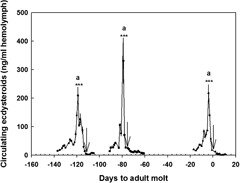
In lobsters, a steroid hormone called ecdysteroid spikes during the pre-molt phase and declines sharply after molting. Source: J. Sook Chung
April 3, 2024 — I just saw Dune 2 at the theater, but far more noteworthy is this YouTube of a lobster molting. I can confidently claim that before that video I had never spent a minute of my life thinking about lobsters molting. To be honest, if you had asked me last year if lobsters molt I probably would have said "No". But, I mean, watch the video (variable speed is fine). What a fascinating slash beautiful slash disgusting slash painful slash magical slash moving thing to watch. Can you imagine going through something like that over and over again in your life? I guess humans should be thankful for our endoskeletons.
Why do lobsters molt?
Lobsters molt so they can grow. Lobsters molt so they can repair damaged or diseased shells. Lobsters grow so they can reproduce. And lobsters molt to enhance their sensory perceptions.
How often are lobsters molting?
Lobsters molt far more frequently when they are young (more than ten times per year) than old (sometimes once every 3 years). They are generally in 4 phases: Pre-molt, Molt, Post-molt, or Inter-molt. The critical molting days are always brief, but in their later days lobsters spend less time in the Inter-molt phase and instead more time in drawn out Pre-molt and Post-molt phases.
Why do I think lobster molting might be relevant to understanding human brains?
In my quest to find a more accurate model of bipolar disorder, I was wondering if human brains go through a similar process to lobsters that we haven't properly understood yet. Like lobsters, humans brains are contained inside a skeleton (the skull). While we clearly don't molt our skulls, I wonder if there is some similar natural transformative cyclical process designed to keep our brains growing, shed damaged mental models of the world, improve reproduction, and enhance sensory perceptions. Could the cycles of bipolar disorder be a natural phasic phenomena experienced by all humans, and those labeled "bipolar" just experience more intense molts than others, for some reason?
It seems like lobsters have no choice but to keep molting (except for the ones moved to captive, controlled environments designed to stop molting, like supermarket tanks where they go before being boiled to death). Maybe they are really stoked with their current shell, but nature says "sorry, too bad, time to grow", and gives them the painful boot. Similarly, maybe brains go through cycles where even if you were comfortable with your current interface to the world, nature has designed it so you will have to molt it anyway. It is a painful and vulnerable process (the mortality rate of a lobster molt is 10%), and no guarantees your new shell will be better than the last, but apparently, with lobsters at least, it is a risk that pays off in the game of natural selection.
Notes
While researching lobsters (for the first time), I also came upon this interesting post on a different topic releated to lobsters and brains.